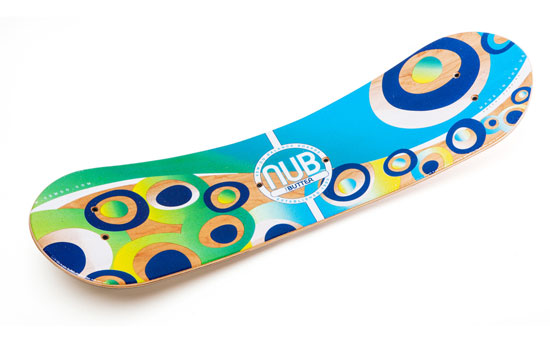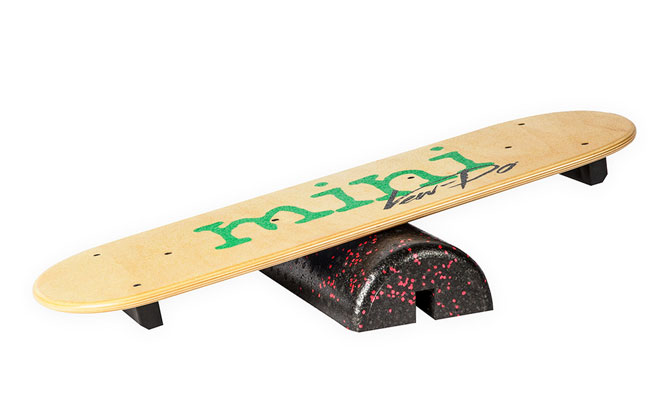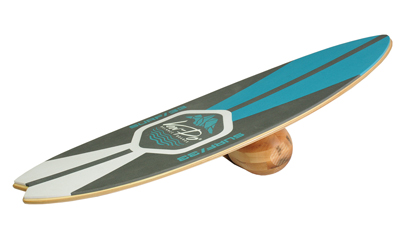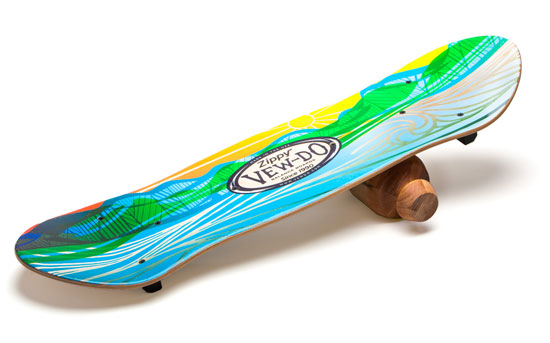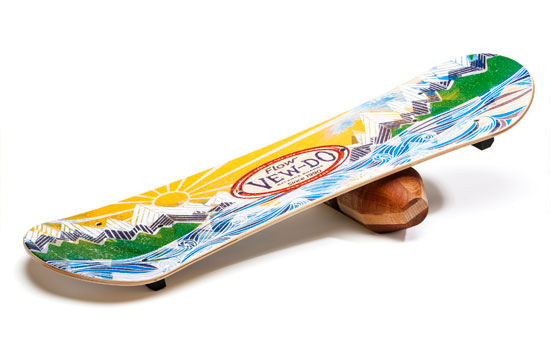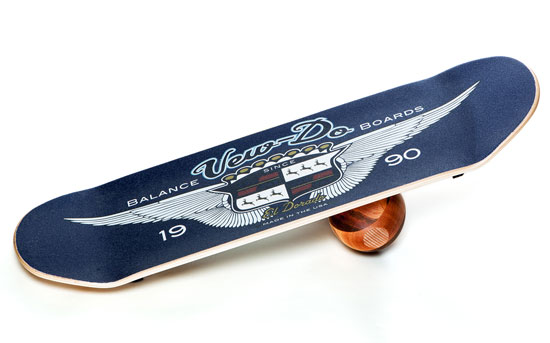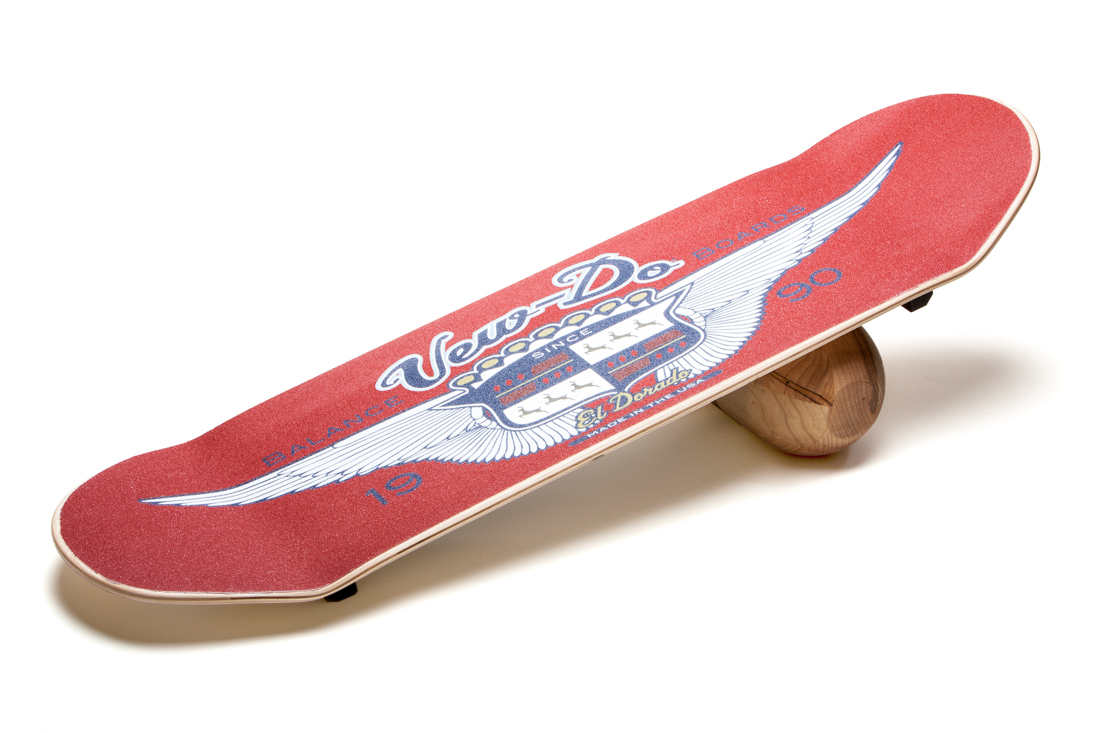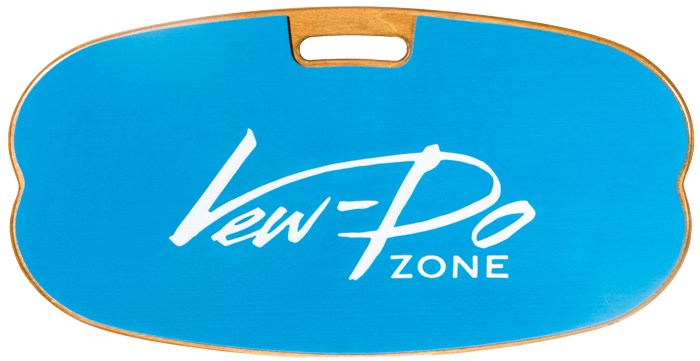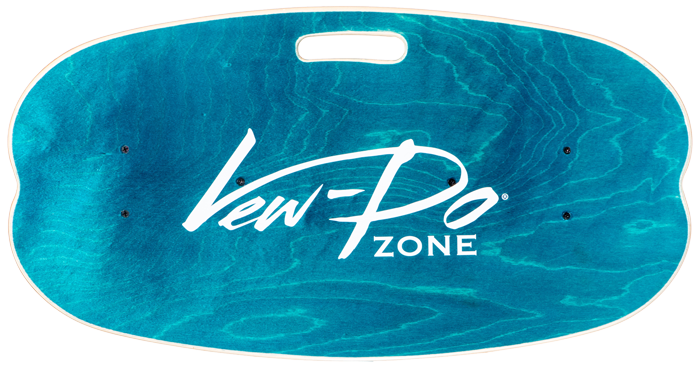Strength, Balance Recovery Training & Sports Injury Prevention
If you ask a roomful of people to raise their hands if they thought they have good balance, just about everyone would raise their hand.
 |
This is normal as most people have reasonably good balance skills for everyday activities. Balance training is one of the most underutilized training protocols in sports for one simple reason. Everyone assumes they have good balance so they don't bother to train to make it better. People assume that balance is an involuntary activity like breathing or your heartbeat. Its not. Balance is a learned skill; just like walking, kicking a football or throwing a baseball. Not only is it a learned skill; it can also be improved. Possessing superior strength and balance skills will be one of your most important assets for injury prevention in any sport or physical activity. Now, the best way to demonstrate this is to immediately put you on a Vew-Do Balance Board, but by using it the first time you would have an excuse for seemingly poor balance because you've never used a Vew-Do before. Instead, try this 3 part balance test. First, stand on one leg. Pretty easy, so you may still feel confident about your balance skills. Then tilt your head back. Now the fun starts. Even people with good balance skills need a few seconds to acclimate to this sudden, unfamiliar position. One or two outrigger steps with their free leg and most can remain on one leg, albeit with a lot of wiggling and body contortions (aka balance recovery). Step three is to close your eyes while your head is still tilted back. Anyone that can hold that position for 30 seconds or more has pretty good balance skills. Unfortunately, the average time for most people before balance recovery is needed is about 8 to 12 seconds. Now that I have their attention, I give them a short workshop in the 3 components of the human balance system. |
The human balance system has three parts and they all work together. They are:
The Vestibular (inner ear)
The Visual (depth, velocity and motion perception)
The Somatic Sensory (proprioception and exteroception)
Performing the 3 part exercise simply disrupts the common use of the three balance systems. Balancing on one leg alone doesn't tax your balance enough to provoke an extreme balance recovery situation (the whole concept behind balance training).
First, it doesn't stimulate the body to adjust to the loss of one of the three balance systems. But, tipping the head back suddenly throwing off both the vestibular and visual systems and closing your eyes does.
The inner ear has to adjust to tilting of the head while on one leg (not a normal occurrence in everyday activity). Even while the eyes are still open, they still use feedback on depth and motion and they are not used to visual signals bouncing off a high ceiling versus the floor.
Closing the eyes completely removes visual input to balance recovery.
Closing the eyes is the only piece of the balance system that can easily be turned on and off. All you need to do is close your eyes or occupy a totally pitch black environment to replicate loss of visual perception.
Lastly, proprioceptors …which are specialized nerve endings in muscles, tendons and joints that help detect minute changes in body position in relation to other parts of the body and the environment.
Think of the sensation of stepping in squishy mud as opposed to solid ground. Your proprioceptors help you maintain stability.
There are high concentrations of these proprioceptors buried under the skin in your hands and feet. Proprioceptors help you to quickly adjust to the changing environment.
Science of Strength & Balance Recovery for Injury Prevention
Strength training helps you avoid injury because it increases your ability to generate and absorb higher forces to your body. Becoming more skilled at balance recovery helps make you more adaptable to being off balance and more skilled at recovering agility from unbalanced situations.
Many sports injuries occur from two circumstances. The first is when the physical limits of an athlete's body is pushed beyond what the body knows as normal. This may be caused by opponents, themselves or the environment. Your body knows when you're trying to generate or absorb forces greater than what it has been trained to do.
The second is when athletes incorrectly twist, turn, jump, land, generate or absorb forces in an unbalanced situation. Here are some examples of ankle and knee injury causes:
- Skiers, snowboarders, skateboarders and other action sports athletes becoming unbalanced at high speeds.
- Basketball and volleyball players jumping and landing incorrectly.
- Weightlifters becoming unbalanced under load.
- Football and soccer players becoming unbalanced due to interaction with opponents.
- Wrestlers executing and countering moves while being off balance.
- Gymnasts and cheerleaders becoming unbalanced during vaults, landings, dismounts and tumbling. The list goes on.
Aside from being just plain fun to use, once you start balance recovery and strength training on the Vew-Do balance board and break out of your comfort zone, (normal routine) your body responds to the stimulus by recruiting and strengthening nearby muscles and tendons. In some cases, muscles you rarely use during training.
The same is true for balance training. Train from the unbalanced zone and your muscles, nerves and tendons will recruit balance recovery motion from its balance training memory bank.
3 Favorite Strength & Balance Recovery Exercises
Vew-Do Balance Board Kettlebell Squats - With kettlebells in hand, mount the balance board, perform a squat and return to the standing position. For added strength training, perform a double shoulder shrug during the downward phase and again on the upward phase. Gives total body strength and balance training with higher concentrations on the lower back, calves, quads, ankles and kness.
Vew-Do Balance Board Kettlebell Lunges - With kettlebells in hand, mount the balance board in a standard staggered lunge stance. Perform lunge sets that include switching between right and left. Again, for added strength training, perform a double shoulder shrug during the downward phase and again on the upward phase. Gives full body strength and balance training with higher concentrations on the ankles, knees, calves and hamstrings.
Vew-Do Balance Board Seesaws - Performed on a Vew-Do using a teeter rock. With knees bent, remain in a 90 degree squat position. Slightly shift weight to right leg and push down. Shift weight to the left leg and push down. Repeat from left to right. Gives zero impact strengthening of quads, hamstrings, knees (ACL - MCL), ankles and their associated muscles and tendons.
Isn't it time you started making injury prevention part of your total training protocol?
By: Rick Contrata
If you ask a roomful of people to raise their hands if they thought they have good balance, just about everyone would raise their hand.
 |
This is normal as most people have reasonably good balance skills for everyday activities. Balance training is one of the most underutilized training protocols in sports for one simple reason. Everyone assumes they have good balance so they don't bother to train to make it better. People assume that balance is an involuntary activity like breathing or your heartbeat. Its not. Balance is a learned skill; just like walking, kicking a football or throwing a baseball. Not only is it a learned skill; it can also be improved. Possessing superior strength and balance skills will be one of your most important assets for injury prevention in any sport or physical activity. Now, he best way to demonstrate this is to immediately put you on a Vew-Do Balance Board, but by using it the first time you would have an excuse for seemingly poor balance because you've never used a Vew-Do before. Instead, try this 3 part balance test. First, stand on one leg. Pretty easy, so you may still feel confident about your balance skills. Then tilt your head back. Now the fun starts. Even people with good balance skills need a few seconds to acclimate to this sudden, unfamiliar position. One or two outrigger steps with their free leg and most can remain on one leg, albeit with a lot of wiggling and body contortions (aka balance recovery). Step three is to close your eyes while your head is still tilted back. Anyone that can hold that position for 30 seconds or more has pretty good balance skills. Unfortunately, the average time for most people before balance recovery is needed is about 8 to 12 seconds. Now that I have their attention, I give them a short workshop in the 3 components of the human balance system. |
The human balance system has three parts and they all work together. They are:
The Vestibular (inner ear)
The Visual (depth, velocity and motion perception)
The Somatic Sensory (proprioception and exteroception)
Performing the 3 part exercise simply disrupts the common use of the three balance systems. Balancing on one leg alone doesn't tax your balance enough to provoke an extreme balance recovery situation (the whole concept behind balance training).
First, it doesn't stimulate the body to adjust to the loss of one of the three balance systems. But, tipping the head back suddenly throwing off both the vestibular and visual systems and closing your eyes does.
The inner ear has to adjust to tilting of the head while on one leg (not a normal occurrence in everyday activity). Even while the eyes are still open, they still use feedback on depth and motion and they are not used to visual signals bouncing off a high ceiling versus the floor.
Closing the eyes completely removes visual input to balance recovery.
Closing the eyes is the only piece of the balance system that can easily be turned on and off. All you need to do is close your eyes or occupy a totally pitch black environment to replicate loss of visual perception.
Lastly, proprioceptors …which are specialized nerve endings in muscles, tendons and joints that help detect minute changes in body position in relation to other parts of the body and the environment.
Think of the sensation of stepping in squishy mud as opposed to solid ground. Your proprioceptors help you maintain stability.
There are high concentrations of these proprioceptors buried under the skin in your hands and feet. Proprioceptors help you to quickly adjust to the changing environment.
Science of Strength & Balance Recovery for Injury Prevention
Strength training helps you avoid injury because it increases your ability to generate and absorb higher forces to your body. Becoming more skilled at balance recovery helps make you more adaptable to being off balance and more skilled at recovering agility from unbalanced situations.
Many sports injuries occur from two circumstances. The first is when the physical limits of an athlete's body is pushed beyond what the body knows as normal. This may be caused by opponents, themselves or the environment. Your body knows when you're trying to generate or absorb forces greater than what it has been trained to do.
The second is when athletes incorrectly twist, turn, jump, land, generate or absorb forces in an unbalanced situation. Here are some examples of ankle and knee injury causes:
- Skiers, snowboarders, skateboarders and other action sports athletes becoming unbalanced at high speeds.
- Basketball and volleyball players jumping and landing incorrectly.
- Weightlifters becoming unbalanced under load.
- Football and soccer players becoming unbalanced due to interaction with opponents.
- Wrestlers executing and countering moves while being off balance.
- Gymnasts and cheerleaders becoming unbalanced during vaults, landings, dismounts and tumbling. The list goes on.
Aside from being just plain fun to use, once you start balance recovery and strength training on the Vew-Do balance board and break out of your comfort zone, (normal routine) your body responds to the stimulus by recruiting and strengthening nearby muscles and tendons. In some cases, muscles you rarely use during training.
The same is true for balance training. Train from the unbalanced zone and your muscles, nerves and tendons will recruit balance recovery motion from its balance training memory bank.
3 Favorite Strength & Balance Recovery Exercises
Vew-Do Balance Board Kettlebell Squats - With kettlebells in hand, mount the balance board, perform a squat and return to the standing position. For added strength training, perform a double shoulder shrug during the downward phase and again on the upward phase. Gives total body strength and balance training with higher concentrations on the lower back, calves, quads, ankles and kness.
Vew-Do Balance Board Kettlebell Lunges - With kettlebells in hand, mount the balance board in a standard staggered lunge stance. Perform lunge sets that include switching between right and left. Again, for added strength training, perform a double shoulder shrug during the downward phase and again on the upward phase. Gives full body strength and balance training with higher concentrations on the ankles, knees, calves and hamstrings.
Vew-Do Balance Board Seesaws - Performed on a Vew-Do using a teeter rock. With knees bent, remain in a 90 degree squat position. Slightly shift weight to right leg and push down. Shift weight to the left leg and push down. Repeat from left to right. Gives zero impact strengthening of quads, hamstrings, knees (ACL - MCL), ankles and their associated muscles and tendons.
Isn't it time you started making injury prevention part of your total training protocol?
By: Rick Contrata
How to Treat Cerebral Palsy Using a Balance Board
How balance boards and kids balance board training was proven to be an effective tool for improving the quality of life for children, ages (7-13) with Cerebral Palsy

If you're here, then you're already aware of the physical characteristics of children with Cerebral Palsy. Along with poor motor skills or coordination, there are also injury risks from falling.
You probably know that some of the symptoms of Cerebral Palsy are muscle tightness or spasticity; involuntary movement and disturbance in gait or mobility. This can translate to poor balance, coordination and recovery of stability skills which can lead to the risk of injury from falls. What you probably didn't know is this. There's a way you can help reduce the risk of injury and improve a Cerebral Palsy child's quality of life
Quality of life enhancement means different things to different people. What you will discover below is the tool and the method used to modify postural control mechanisms of children with Cerebral Palsy.
The benefits to this are that something as simple as balance board training for the recovery of stability in a Cerebral Palsy child can help reduce injuries caused by poor balance, coordination and motor skills. It only makes sense that increased balance, coordination, stability and recovery skills can also increase their safety, scope and level of activity and give them the confidence to be more independent.
This isn't something we've conjured up. In fact, it was proven in a research study done by the University of Oregon and the University of Washington. The research showed this.
When children with 2 forms of Cerebral Palsy, (spastic dipleagia and spastic hemiplegia) used a moving platform to practice balance training for recovery of stability, they showed significant improvement with reduced COP (center of pressure) and TTS (time to stability.) The study also proved that these skill gains were still present for at least one month following the training.
The importance of this study is two-fold. First, balance training in children with Cerebral Palsy can modify muscle response characteristics. Secondly, it dispelled the belief of a minority of skeptics that claim balance training isn't transferable to real-life physical and motor activity. These skeptics consist of those untrained and unlicensed in the field of physiology, mostly fitness and personal trainers. You can download a PDF copy of the conclusions from the study from the link below:








